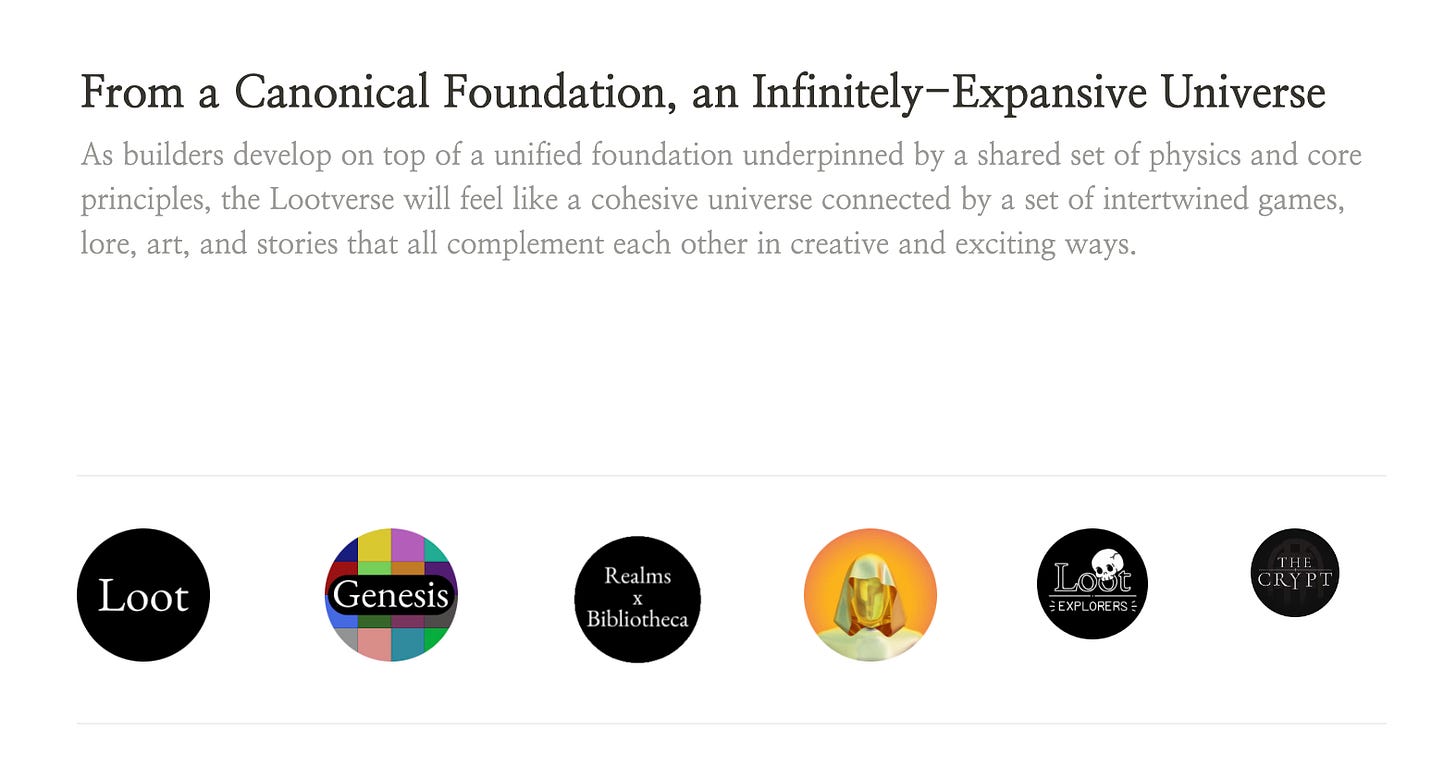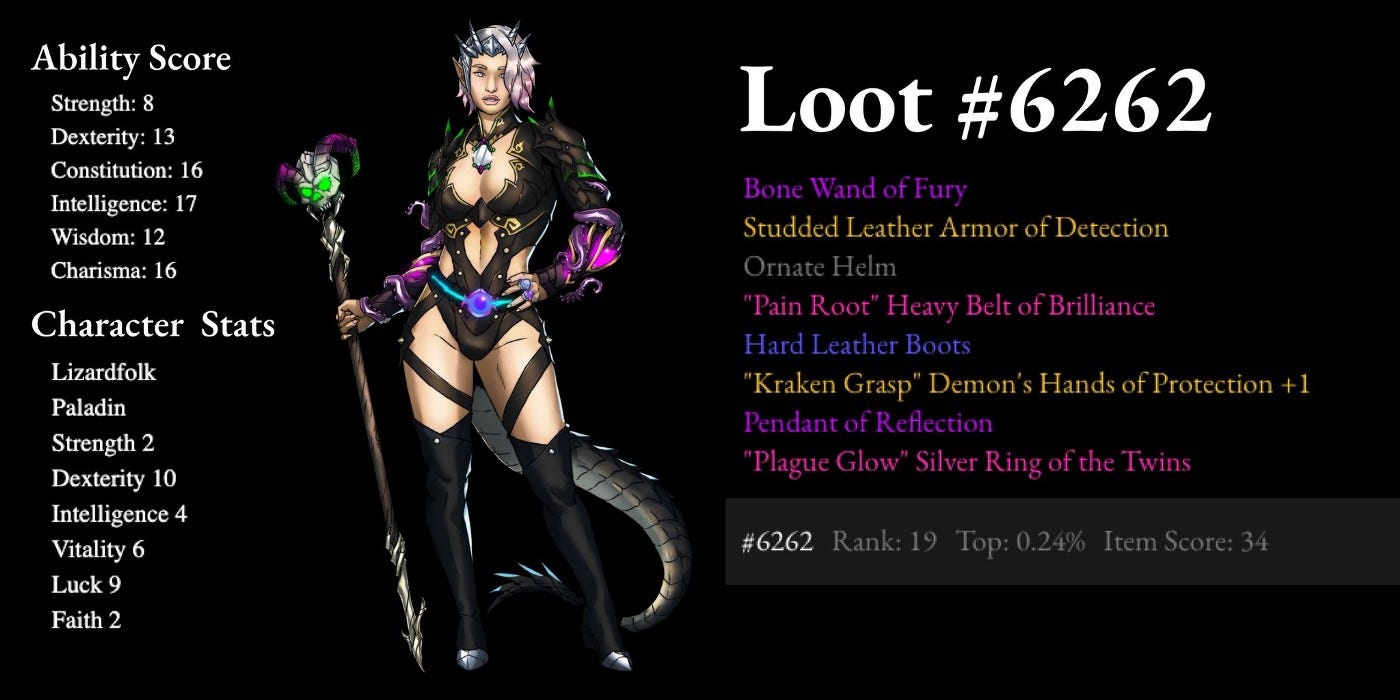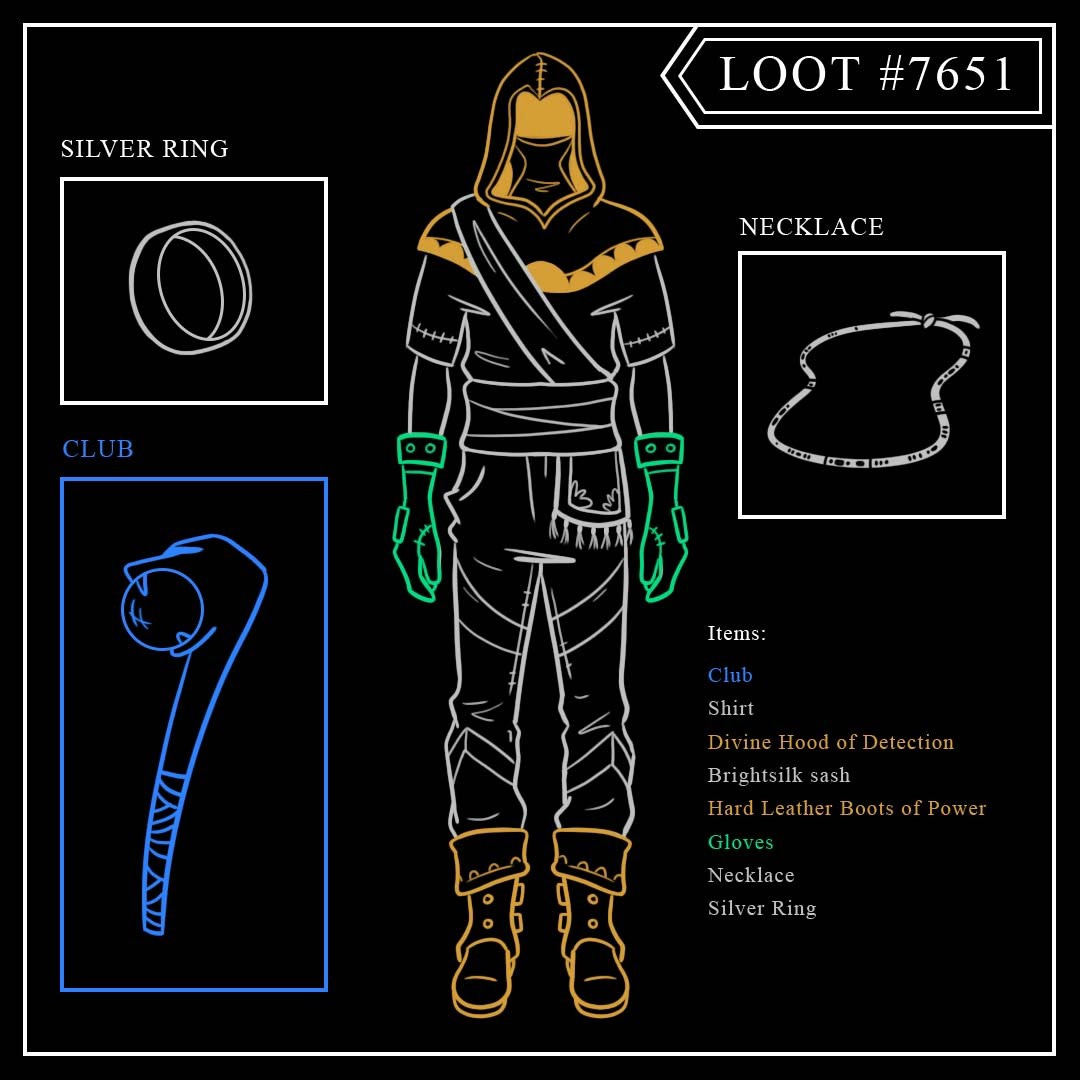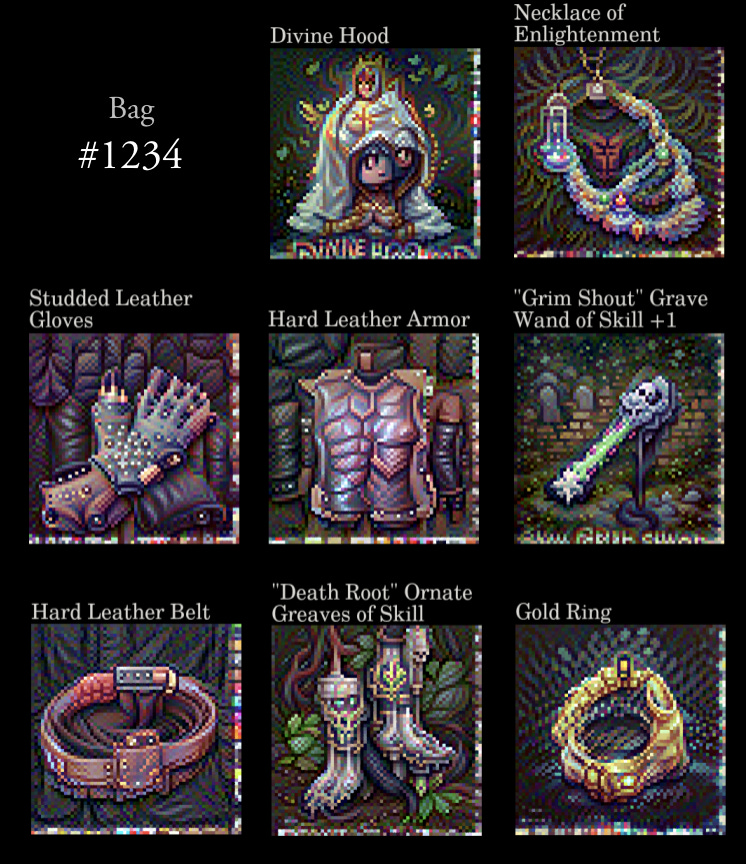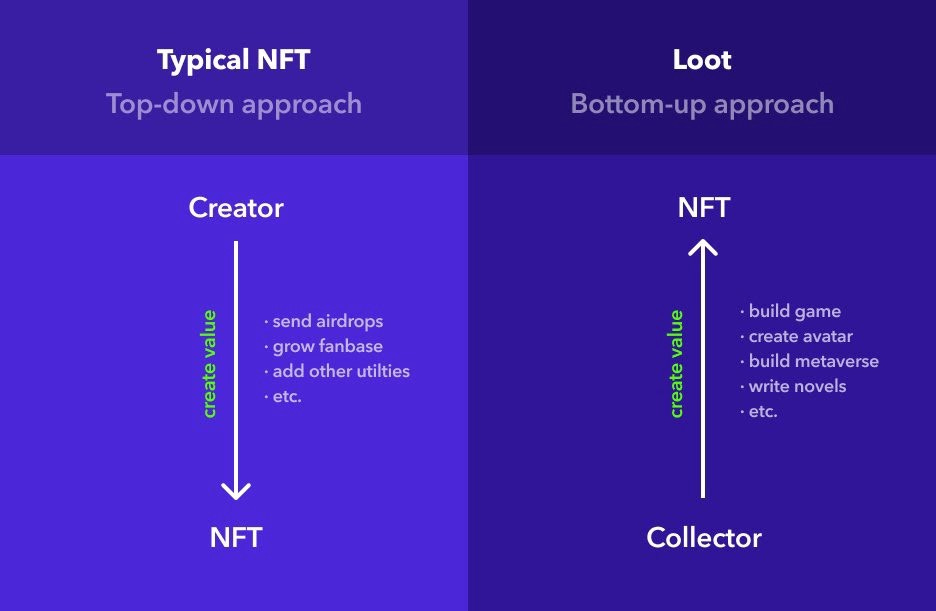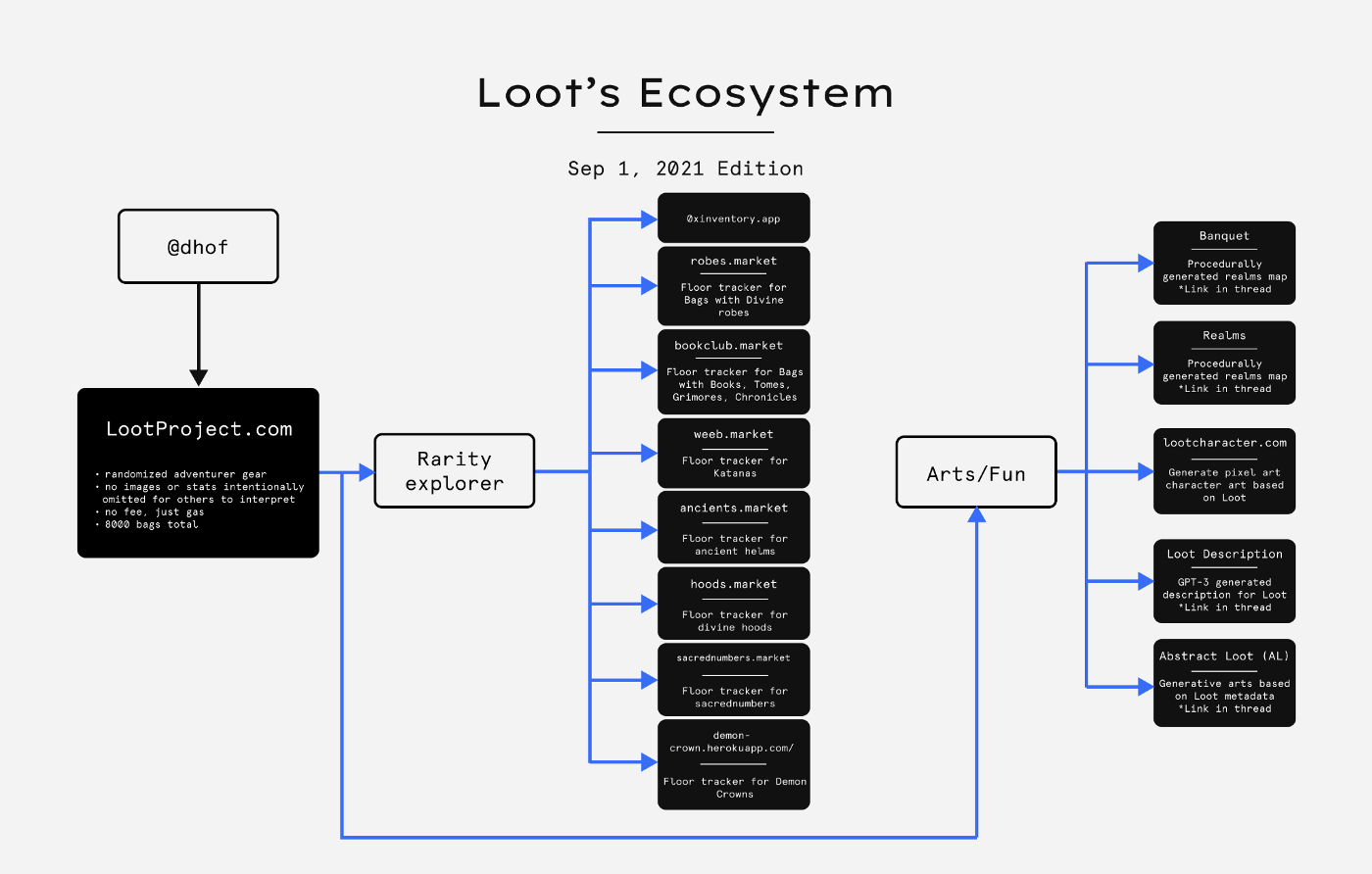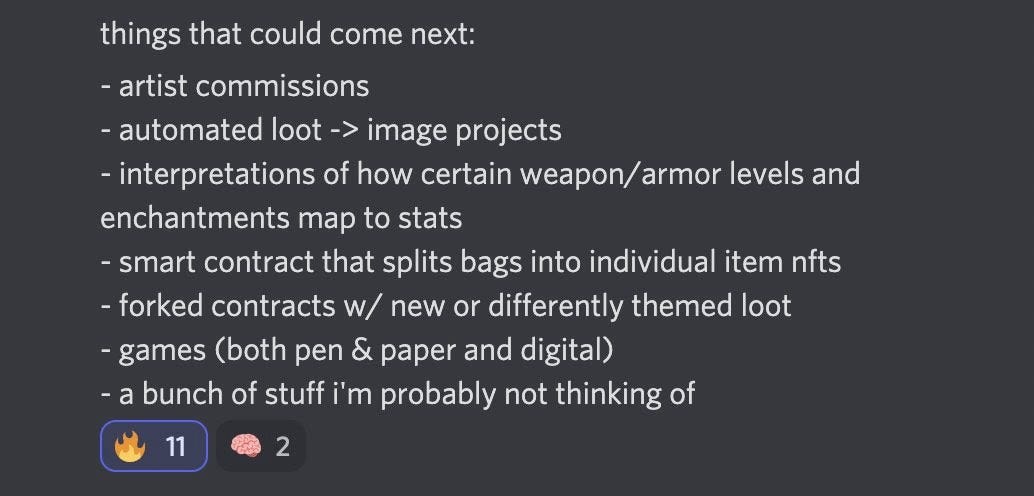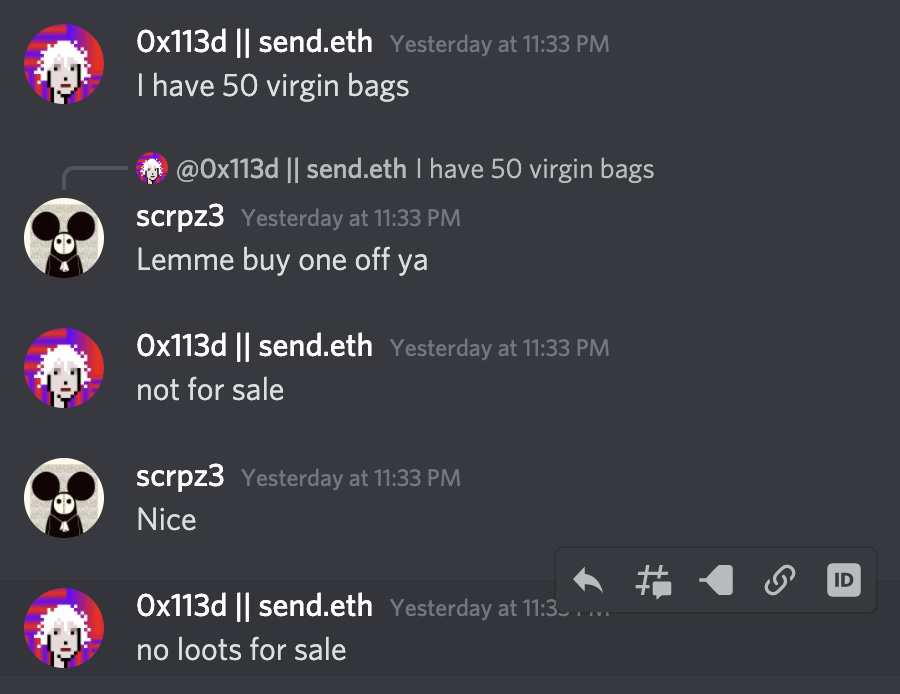Why Did Loot Fail?
The quest to finding a sustainable model for continuous bottom-up building communities
One of the first things in cryto I’ve researched about is Loot, the famous 8,000 item collection with nothing but a black box but 8 lines of words apparently referencing bizarre gaming items. I’ve included the piece I’ve written then at the bottom of this piece. For those uninitated in Loot and what it mean, you’re encouraged to check that section out first.
The project captured my interest not least because of its explosive price action but the vision it sold. Loot is an NFT collection where each NFT is nothing but a set of metadata of words. The words themselves suggest the NFT symbolises an gaming item, but there is no indication or limit as to what kind of game that these gaming items exist. So, anyone can build any game on top of it! This became known as a “bottom-up game” architecture, where the game is not dictated or imposed from one central, core entity from above, but via presumably a multitude of "grassroots” entities. And that vision sought got folks hyped about the Metaverse narrative - it was argued, in light of loot, the most sensible interpretation of what the metaverse is must be a collection of protocols where assets can freely flow in between.
Everybody got the message, and people started building. But almost a year since Loot dropped, Loot’s price has collapsed and the projects building on top on Loot have either fizzled out or drifted so far away from Loot that the black pictures no longer even play a part in their ecosystems anymore.
Why did loot fail?
What does failure in this Context mean? Loot sold a vision of bottom up games - where one single unifying asset would be shared by multiple gaming economies.
These economies would be parallel, that is, they would not be interacting with each other - which was fine. But these worlds, these economies, these games, would all be connected with Loot. Loot can be used in these games and they would be functionable in these games, regardless of how these games themselves function. In simple words, Loot would become an interoperable asset amongst many protocols.
In this sense, Loot has failed. Not only are there no parallel economies built on top, there aren’t even multiple economies w
here loot is a core asset. Magic has drifted far away from its Loot origins and it doesn’t
It’s fair to say that loot has failed to achieve that because not only were there no parallel economies built on top, there aren’t even multiple economies. Magic does not utilise loot assets.
Economic Reasons
Reason 1: Insufficient distribution / supply of base asset
Reason 2: no emissions of further incentives
Reason 3: core asset failed as a schelling point
Other reasons
The immaturity of on-chain gaming infrastructure has made it impossible for projects to build their games on Ethereum. They had to migrate to other blockchains where the kind of intense and highly demanding computation gaming requires is up to the task. Both Treasure DAO and Realms x Bibliotheca DAO moved to Arbitrum. The latter eventually migrated to Starknet. Starknet’s revamp of the Cairo language via regenesis didn’t help. The infrastructure wasn’t simply not there, and it took too long to arrive for the interest to be sustained.
Other sustainable communities
Poland ball
Nounsdao
How did alternate histories and conlang communities sustain itself? How about wikipedia?
Wikipedia: showcase of work - ownership
How is limit break different
PS: The Loot Project (Sep 2, 2021)
On the 28th Aug, 8000 NFTs, each a picture of simply 8 lines of white words imposed on a black background were released by dhof, creator of vine, free to be minted. And within 5 days, it has turned the NFT space upside-down.
What exactly is the Loot project? As it says on its extremely minimalistic website: “Loot is randomized adventurer gear generated and stored on-chain. Stats, images, and other functionality are intentionally omitted for others to interpret. Feel free to use Loot in any way you want.”
Each Loot NFT is literally a black card with 8 gear items, namely:
Weapon
Chest
Head
Waist
Foot
Hand
Neck
Ring
Within merely 5 days, the lootproject has exploded in terms of its ecosystem complexity and reach. 9k ETH (~$30 million) of Loot volume has traded on OpenSea’s secondary market, with a floor price of 5.5 ETH each. What is going on?
What is the Lootproject about?
The Lootproject is completely open to interpretation, but developments thus far have on the whole taken towards a RPG-like direction. Various artistic renditions of the weapons and objects described by the 8 attributes have sprung up all over twitter and discord, followed by poems, storylines, and maps of potential gaming environments. And this is precisely what the Lootproject is about — a community-driven, bottom-up construction of multiple universes for the Loot to exist and to be rendered.
Here are some visual renditions by members of the community:
And here, is one particular interpretation that renders all 8000 loot bags:
https://www.lootcharacter.com/
The loot discord has now chatrooms for builders, writers, and meme-makers. In the writer chatroom, there is talk of writing out stories, poems, proposal for the names of ERC20 tokens to serve as the currency / currencies of the Loot universe, and NFTs of spells.
Why is the Lootproject significant?
Somewhere on twitterspace did someone utter “Bitcoin was the Money Primitive, and the Lootproject is the Metaverse Primitive”, and that’s exactly the idea.
Regardless of how the “metaverse(s)” is understood, be it a super-immervse virtual reality internet or an internet with shared state so that objects can be moved between platforms, the Lootproject has demonstrated what a crucial mechanism for maintaining object identity across metaverses would look like. In the past, an NFT was paired with a GIF, a concrete artistic rendition, in a particular style, in a particular artistic language, in a particular theme. The Lootproject has proven two things: (1) it is possible and entirely viable to liberate an object from its visual representation while maintaining cross-metaverse (i.e. cross-platform) identity, and (2) that such separation between NFT the code (i.e. the object) and the visual representation, does not jeopardise the value of the object. A divine robe is a divine robe, be it in some Middle-Earth metaverse, some Westeros metaverse, or a Narnia metaverse.
More importantly, the lootproject is an earth-shattering proof of concept and a paradigm shift — and its application will be most apparent when metaverse infrastructure matures. One take from Not3Lau_Capital: LOOT dropped just 5 days ago and has taken the whole NFT community by storm with simple lines of text instead of fancy jpegs. So, What exactly is it? It’s a deceptively simple concept. “Just a TXT file on a black background,’’ consisting of randomly generated fantasy adventurer loot in a set. The founder, @dhof of Vine, Blitmap and Supdrive fame, did not set any secondary sale fees, allowing the community to use it anyway they wanted, unbeholden to him. A more substantial elaboration could be found here.
Or as tandavas.eth put it, in the past, artists defined every aspect of an NFT and offer it up for minting by collectors. With the Loot Project, the whole concept is turned upside-down. Value potential is no longer straightforwardly embedded and defined in an NFT by its creator, but is something awaiting creation by the collector community, who does so by building games, creating avatars, building a metaverse, write novels, so the NFT can uptake value.
It is for the very potential that the community around loot has exploded, as summarised in this graphic by lililashka:
Writers, artists, poets, novelists, graphic designers, video-makers, are all free to make what they want to make to interpret these collectibles.
World-building becomes communal
Though one might dismiss this as little more than the worst of nerd culture and community, with dynamics reminiscent of the Bad Apple! community, the revolutionary nature of the loot project truly reveals itself when viewed in conjunction with the potential of metaverse technology.
The key to note here is that as Robert Leshner put it “What sets LOOT apart is that there are smart-contract readable parameters for each of the inventory slots, so that games and experiences can be built on top. Imagine logging into World of Warcraft with your LOOT — which is different from everyone else’s.”
The Lootproject has also demonstrated the viability of a completely new NFT community dynamic, where the community is not only free to participate in the world-building, but free to secede and build their own world if they want to, with no fear that objects from the worlds they secede from would be rendered unusable in their own. As zoink points out, two paths are emerging in the NFT space. The first path is to first build a universe, unleash the NFTs, but the intellectual property rights are held by the creators. The second, is to first form a community, so you can build the universe. All the IP is given away, so the community might grow as freely as possible.
This stands in stark contrast to existing fictional universes and world-building projects, which are tightly controlled by mega-corporations like Disney and foundations like the Tolkien estate. Seasoned wookieepedia users and tolkienites would be familiar with how frustrating it is to be barred from building these worlds that one loves, or how infuriating it is to see Red-headed elves. In the past, one would have to just take and swallow these decisions made by faceless marketing committees and the mutilation they inflict on the lore. Loot has demonstrated that this no longer necessarily needs to be the case. If Star Wars had been running on a Lootproject structure, the “Hayden Christensen Force Ghost” and the “Greedo shoots first” retcons, as well as the complete retcon of the Expanded Universe (aka “Legends”) would have been much less meaningful. Fans and community members could just ignore them, for they would always be canon in their own metaverse.
Sure, canon will still be a thing. It is not like there is no “canon” in the Loot universe. A divine robe is a divine robe because its divine robe status is canon. The canonicity of the divine robe is determined at inception, at the very start. However, what makes a fictional world with Loot-dynamics different, is that once initial canonicity has been established, it is difficult, if not nigh meaningless to further inject canonicity. Suppose George R. R. Martin made Loot-like NFTs for Cersei Lannister, Olenna Tyrell, and King Jeoffrey (think Loot NFTs but with just names of them three). He unleashes them and communities start to build around them. George would have no power to disavow or cut off any interpretation that he does not like, nor does he hold the power to ban someone with a wallet holding a Cersei Lannister Loot walking into a metaverse where Cersei Lannister has green hair instead of gold hair.
Communities would also have much greater power over their universes. Just like the Divine Robes Lounge, communities can build a Jar Jar Binks free star wars universe, spaces where only Sith Lords can enter, or Middle Earths with no red-headed-elves.
Is Loot the seed for a game (or set of games)? Or is the process of building around Loot the actual game? The fact is that it’s both.
What is next?
The growth of the Loot community has been explosive, and there are definitely even more developments ahead. Some of dhof’s predictions include:
Here is a list of some of the offshoot projects and useful resources of the Loot community:
Loot unbundling — smart contracts to unbundle individual items from loots so items may be individually traded as NFTs.
Synthetic Loot — smart contracts that return a “virtual nft” of loot based on a given wallet, thereby democratising loot and allowing it for mass adoption.
Divine Lodge — a community where only individuals who hold divine Loot may enter.
The BookClub — a community for loot holders with books, tomes, grimoires, and chronicles, which is sort of similar to the Divine Lodge.
A family of Loot derivatives and add-ons and forks, including Lootfoes, Loot for ballers, Loot for Apes, PolyLoot, and DopeWarsLoot.
Storyblocksnft: a Loot-like project except that the 8 attributes inside a Loot are replaced with AI-generated sentences, which may be used to create stories.
Just as there is room for the community to work out the pricing logic, there is also room for the community to work out some consensus for measuring rarity. Indeed, different schools of thought might soon evolve and debut. Analysis tools comparable to etherscan for community members to see who is holding what loot have already been developed, though galleries where different interpretations of the same Loot have yet to emerge. It is also possible, as seen in the following screenshots, for some kind of purity culture to develop.
And given more and more tools building up the Loot infrastructure are emerging every day, we can expect more and more sophisticated forms of culture to gradually emerge.
Concluding Remarks
It is pretty apparent that Loots have already made their place in crypto history. A few years from now, people would look at their holders in awe, across the myriad metaverses.
【Why did Loot fail? 23rd July 2024】
I think Loot failed because it hasn't sufficient economic vessels to built into its mechanism to produce cryptoeconomical outgrowth that unifies them with common systemicality. The fact that both Treasure and Biblioteca now have only nominal connection to the original Loot project, is fact that Loot was too abstract and underengineered that it was forced to rely too much on social consensus. In fact, the bloom of loot copies latched onto that overwhelming explosion of market interest (social consensus explosion), and deprived Loot itself of oxygen, and then it died.
Loot's dream was to be a base layer for multiple games on top, but it didn't materialize because the initial batch of flora realised they don't need the base layer, and they went off.
I think this something that the entire class of picture based NFTs should pay attention. I think it is possible that the entire asset class of GIF NFTs will just go extinct - because they are too financially uninteresting - you can't do anything with it aside from just trading. But it doesn't need to be like that.
If NFTs behave more like artificial life, with not just financial properties but also financial interactivity, then it will be interesting.
https://reflexivityengine.substack.com/p/why-did-loot-fail


